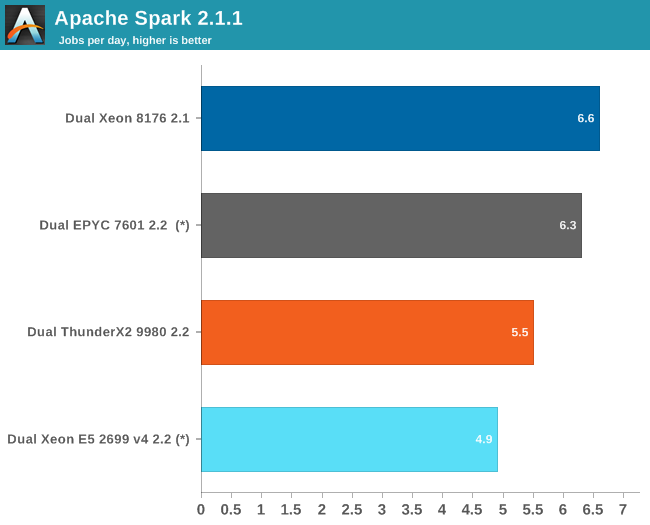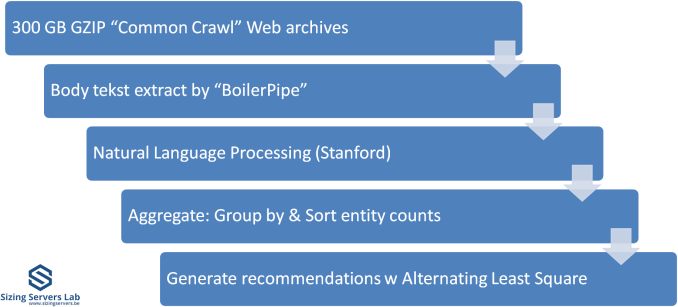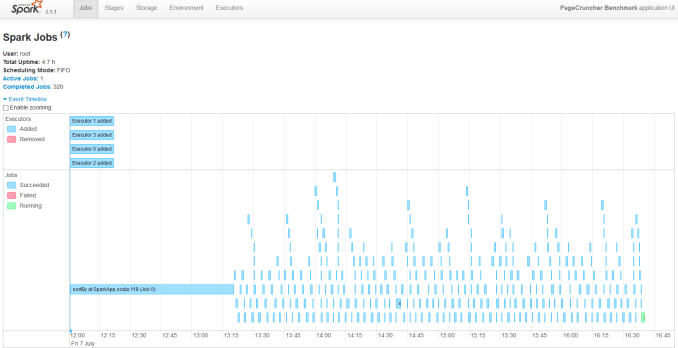Assessing Cavium's ThunderX2: The Arm Server Dream Realized At Last
by Johan De Gelas on May 23, 2018 9:00 AM EST- Posted in
- CPUs
- Arm
- Enterprise
- SoCs
- Enterprise CPUs
- ARMv8
- Cavium
- ThunderX
- ThunderX2
Apache Spark 2.x Benchmarking
Last, but not least, we have Apache Spark. Apache Spark is the poster child of Big Data processing. Speeding up Big Data applications is the top priority project at the university lab I work for (Sizing Servers Lab of the University College of West-Flanders), so we produced a benchmark that uses many of the Spark features and is based upon real world usage.
The test is described in the graph above. We first start with 300 GB of compressed data gathered from the CommonCrawl. These compressed files are a large amount of web archives. We decompress the data on the fly to avoid a long wait that is mostly storage related. We then extract the meaningful text data out of the archives by using the Java library "BoilerPipe". Using the Stanford CoreNLP Natural Language Processing Toolkit, we extract entities ("words that mean something") out of the text, and then count which URLs have the highest occurrence of these entities. The Alternating Least Square algorithm is then used to recommend which URLs are the most interesting for a certain subject.
To get better scaling, we run with 4 executors. Researcher Esli Heyvaert reconfigured the Spark benchmark so it could run on Apache Spark 2.1.1.
Here are the results:

(*) EPYC and Xeon E5 V4 are older results, run on Kernel 4.8 and a slightly older Java 1.8.0_131 instead of 1.8.0_161. Though we expect that the results would be very similar on kernel 4.13 and Java 1.8.0_161, as we did not see much difference on the Skylake Xeon between those two setups.
Data processing is very parallel and extremely CPU intensive, but the shuffle phases require a lot of memory interactions. The time spent on storage I/O is negligible. The ALS phase does not scale well over many threads, but is less than 4% of the total testing time.
The ThunderX2 delivers 87% of the performance of the twice as expensive EPYC 7601. Since this benchmark scales well with the number of cores, we can estimate that the Xeon 6148 will score around 4.8. So while the ThunderX2 can not really threaten the Xeon Platinum 8176, it gives the Gold 6148 and its ilk a run for their money.












97 Comments
View All Comments
Wilco1 - Wednesday, May 23, 2018 - link
You might want to study RISC and CISC first before making any claims. RISC doesn't use more instructions than CISC. Vector instructions are actually quite similar on most ISAs. In fact I would say the Neon ones are more powerful and more general due to being well designed rather than added ad-hoc.HStewart - Wednesday, May 23, 2018 - link
The following site explain the difference using a simple multiply action, where a CISC architecture can do in single instruction, RISC would need to use multiple instructionshttp://www.firmcodes.com/difference-risc-sics-arch...
of course as time move on RISC chips added more complex operations and CISC also found ways to breaking more complex CISC instruction in smaller RISC like microcode increasing the chip ability to multitask the pipeline.
Wilco1 - Thursday, May 24, 2018 - link
The example was about load/store architecture, not multiply. In reality almost all instructions use registers (even on CISCs) since memory is too slow, so it's not a good example of what happens in actual code. The number of executed instructions on large applications is actually very close. The key reason is that compilers avoid all the complex instructions on x86 and mostly use register operations, not memory.Kevin G - Tuesday, May 29, 2018 - link
Raw instruction counts isn't a good metric to determine the difference between RISC and CISC, especially as both have evolved to include various SIMD and transactional extensions.The big thing for RISC is that it only supports a handful of instruction formats, generally all of the same length (traditionally 4 bytes)* and have alignment rules in place. x86 on the other hand leverages a series of prefixes to enhance instructions which permits length up to 15 bytes. On the flip side, there are also x86 instructions that consume a single byte. This also means x86 doesn't have the alignment rules that RISC chips generally adhere to.
*ARM does offer some compressed instruction formats in Thumb/Thumb2 but they those are also of a fixed length. 16 bit Thumb instructions are half size as 32 bit ARM instructions and have alignment rules as well.
Modern x86 is radically different internally than its philosophical lineage. x86 instructions are broken down into micro-ops which are RISC-like in nature. These decoded instructions are now being cached to bypass the complex and power hungry decode stages. Compare this to some ARM cores where some instructions do not have to be decoded. While having a simpler decode doesn't directly help with performance, it does impact power consumption.
However, I would differ and say that ARM's FPU and vector history has been rather troubled. Initially ARM didn't specify a FPU but rather a method to add coprocessors. This lead to 3rd parties producing ARM cores with incompatible FPUs. It wasn't until recently that ARM themselves put their foot down and mandated NEON as the one to rule them all, especially in 64 bit mode.
peevee - Wednesday, May 23, 2018 - link
The whole RISC vs CISC distinction is outdated for at least 20 years. Both now include a shi(p)load of instruction far outnumbering original CISC processors like 68000 and 8088 (from the epoch of the whole CISC vs RISC discussion), and both have a lot of architectural registers (which on speculative OoO CPUs are not even the same as real register files). ARMv8 for example includes NEON instructions, which is like... "AVX-128" (or SSE3 or smth).A lot of instructions means that both have to have huge decoders, which limits how small the CPU can be (because any reduction in other hardware which decrease performance faster than cost). For 64-bit ARMv8.2 it is very unlikely than an implementation can be made smaller than A55, and it is a huge core (in transistors) compared to even Pentium, let alone 8088.
HStewart - Wednesday, May 23, 2018 - link
I think the big difference between SIMD technologies - even though ARM has included they are not as wide as instructions as Intel or AMD. The following link appears to have a good comparison of chip SIMD comparison in size, To me in looks like AMD is on AVX level 8/16 instead of 16/32 in current chips while ARM including Neon is 4 Wide which is actually less than Core 2 SSE instructions from 10 years ago.https://stackoverflow.com/questions/15655835/flops...
It also interesting to note Ryzen stats - which I heard that AMD implement AVX 256 by combine two 128 together
One thing is that both Intel and AMD CPUs have grown a long ways since 20 years ago. In fact even todays Atom's can out rune most core-2 CPU's from 10 years - not my Xeon 5160 however.
ZolaIII - Thursday, May 24, 2018 - link
It's 2x128 NEON SIMD per ARM A75 core which goes into your smartphone.Even with smaller SIMD utilising TBL QC Centriq is able to beat up an Xerox Gold.
https://blog.cloudflare.com/neon-is-the-new-black/
Wilco1 - Thursday, May 24, 2018 - link
Modern Arm cores have 2-3 128-bit SIMD units, so 16-24 SP FLOPS/cycle. About half of Skylake theoretical flops, and yet they can match or beat Skylake on many HPC codes. Size is not everything...peevee - Thursday, May 24, 2018 - link
"ARM including Neon is 4 Wide which is actually less than Core 2 SSE instructions from 10 years ago"How is it less? It is the same 128 bits, 2x64 or 4x32 or 2x16...
And AMD combines 2 AVX-256 operations (not 2 128-bit SSEs) to get AVX-512.
patrickjp93 - Friday, May 25, 2018 - link
AMD does NOT have AVX-512. They combine 2 128s into a 256 on Ryzen, ThreadRipper, and Epyc.